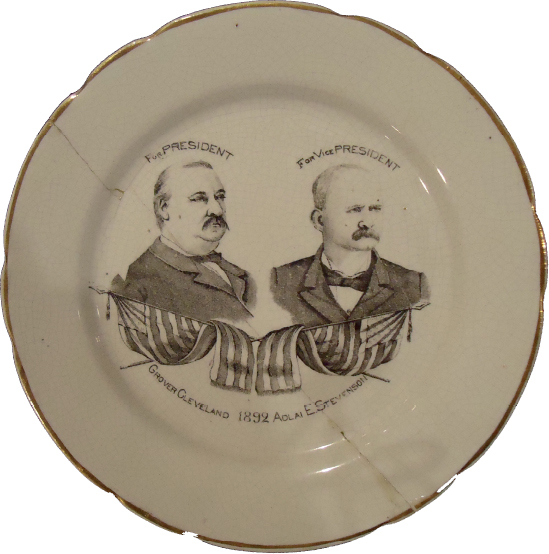An Energized and Entertained Electorate

Despite all the difficulties of the legislative process, political candidates eagerly pursued office and conducted extremely heated campaigns. The electorate considered politics a form of entertainment. Political parties did not stand for clearly stated issues or offer innovative solutions; instead, campaigns took on the qualities of carefully staged performances. Candidates crafted their oratory to arouse the passions and prejudices of their audiences, and their managers handed out buttons, badges, and ceramic and glass plates stamped with the candidates’ faces and slogans.
Partisanship helped fuel high political participation. During this period, voter turnout in presidential elections was much higher than at any time in the twentieth century. Region, as well as historical and cultural allegiances, replaced ideology as the key to party affiliation. The wrenching experience of the Civil War had cemented voting loyalties for many Americans. After Reconstruction, white southerners tended to vote Democratic; northerners and newly enfranchised southern blacks generally voted Republican. However, geographic region alone did not shape political loyalties; a sizable contingent of Democratic voters remained in the North, and southern whites and blacks periodically abandoned both the Democratic and Republican parties to vote for third parties.
Religion played an important role in shaping party loyalties during this period of intense partisanship. The Democratic Party tended to attract Protestants of certain sects, such as German Lutherans and Episcopalians, as well as Catholics. These faiths emphasized religious ritual and the acceptance of personal sin. They believed that the government should not interfere in matters of morality, which should remain the province of Christian supervision on Earth and divine judgment in the hereafter. By contrast, other Protestant denominations, such as Baptists, Congregationalists, Methodists, and Presbyterians, highlighted the importance of individual will and believed that the law could be shaped to eradicate ignorance and vice. These Protestants were more likely to cast their ballots for Republicans, except in the South, where regional loyalty to the Democratic Party trumped religious affiliation.
Some people went to the polls because they fiercely disliked members of the opposition party. Northern white workers in New York City or Cincinnati, Ohio, for example, might vote against the Republican Party because they viewed it as the party of African Americans. Other voters cast their ballots against Democrats because they identified them as the party of Irish Catholics, intemperance, and secession.
Although political parties commanded fierce loyalties, the parties remained divided internally. For example, the Republicans pitted “Stalwarts” against “Half Breeds.” Led by Senators Roscoe Conkling and Chester Arthur of New York, Zachariah Chandler of Michigan, and John Logan of Illinois, the Stalwarts presented themselves as the “Old Guard” of the Republican Party, what they called the “Grand Old Party” (GOP). The Half Breeds, a snide name given to them by the Stalwarts, tended to be younger Republicans and were represented by Senators James G. Blaine, John Sherman, and James A. Garfield of Ohio and George Frisbie Hoar of Massachusetts. This faction claimed to be more open to new ideas and less wedded to the old causes that the Republican Party promoted, such as racial equality. In the end, however, the differences between the two groups had less to do with ideas than with which faction would have greater power within the Republican Party.
Overall, the continuing strength of party loyalties produced equilibrium as voters cast their ballots primarily along strict party lines. The outcome of presidential elec-tions depended on key “undecided” districts in several states in the Midwest and in New York and nearby states, which swung the balance of power in the electoral college. Indeed, from 1876 to 1896 all winning candidates for president and vice president came from Ohio, Indiana, Illinois, New York, and New Jersey.
Review & Relate
|
What accounted for the inefficiency and ineffectiveness of the federal government in the late nineteenth century? |
How would you explain the high rates of voter turnout and political participation in an era of uninspiring politicians and governmental inaction? |